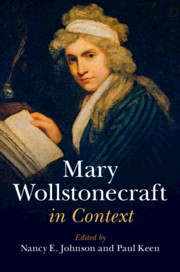Book contents
- Mary Wollstonecraft in Context
- Mary Wollstonecraft in Context
- Copyright page
- Contents
- Illustrations
- Notes on Contributors
- Preface
- Frontispiece
- Chronology
- Part I Life and Works
- Part II Critical Fortunes
- Part III Historical and Cultural Contexts
- The French Revolution Debate
- The Rights of Woman Debate
- Chapter 13 Jacobin Reformers
- Chapter 14 Liberal Reformers
- Chapter 15 Conservative Reformers
- Philosophical Frameworks
- Legal and Social Culture
- Literature
- Suggested Further Reading
- Index
Chapter 14 - Liberal Reformers
from The Rights of Woman Debate
Published online by Cambridge University Press: 16 January 2020
- Mary Wollstonecraft in Context
- Mary Wollstonecraft in Context
- Copyright page
- Contents
- Illustrations
- Notes on Contributors
- Preface
- Frontispiece
- Chronology
- Part I Life and Works
- Part II Critical Fortunes
- Part III Historical and Cultural Contexts
- The French Revolution Debate
- The Rights of Woman Debate
- Chapter 13 Jacobin Reformers
- Chapter 14 Liberal Reformers
- Chapter 15 Conservative Reformers
- Philosophical Frameworks
- Legal and Social Culture
- Literature
- Suggested Further Reading
- Index
Summary
In A Vindication of the Rights of Woman, Wollstonecraft forcefully contended that sexual inequality was based on a false distinction between the “supposed sexual character” of women and men.1 Systematically dismantling the assumptions that resulted in the oppression of women, Wollstonecraft placed the blame squarely on men and insisted that patriarchy demeaned both genders. Many scholars have observed that when she entered the rights of women debate in 1792, she did so more directly and forcefully than her contemporaries.2 Her radicalism also owes its reputation to writing a work devoted to the rights of women, not one that addressed the issue more obliquely through consideration of educational reform. Wollstonecraft believed that a “REVOLUTION in female manners” was necessary before educational reform could be effective;3 since “[m]en and women must be educated, in a great degree, by the opinions and manners of the society they live in … It may then fairly be inferred, that, till society be differently constituted, much cannot be expected from education.”4 Wollstonecraft explicitly situates herself within a masculine political and intellectual tradition, styling herself “a philosopher” expounding “the science of politics.”5 She links the corruption of the monarchy and standing armies to the treatment of women, demonstrating that both belong to the same system of oppression. Adopting a brash, polemical style, she uses the inflammatory rhetoric of degradation, corruption, enslavement, and subjugation to describe the treatment of women, attacking men as tyrants and sensualists who make women into “the toy of man, his rattle, and it must jingle in his ears whenever, dismissing reason, he chooses to be amused.”6 Wollstonecraft did acknowledge her outspokenness: describing how male writers like Rousseau and Dr. Gregory have rendered women “more useless members of society,” she notes, “I might have expressed this conviction in a lower key,” but she commits herself to “the faithful expression of my feelings.”7
- Type
- Chapter
- Information
- Mary Wollstonecraft in Context , pp. 119 - 126Publisher: Cambridge University PressPrint publication year: 2020
- 1
- Cited by

